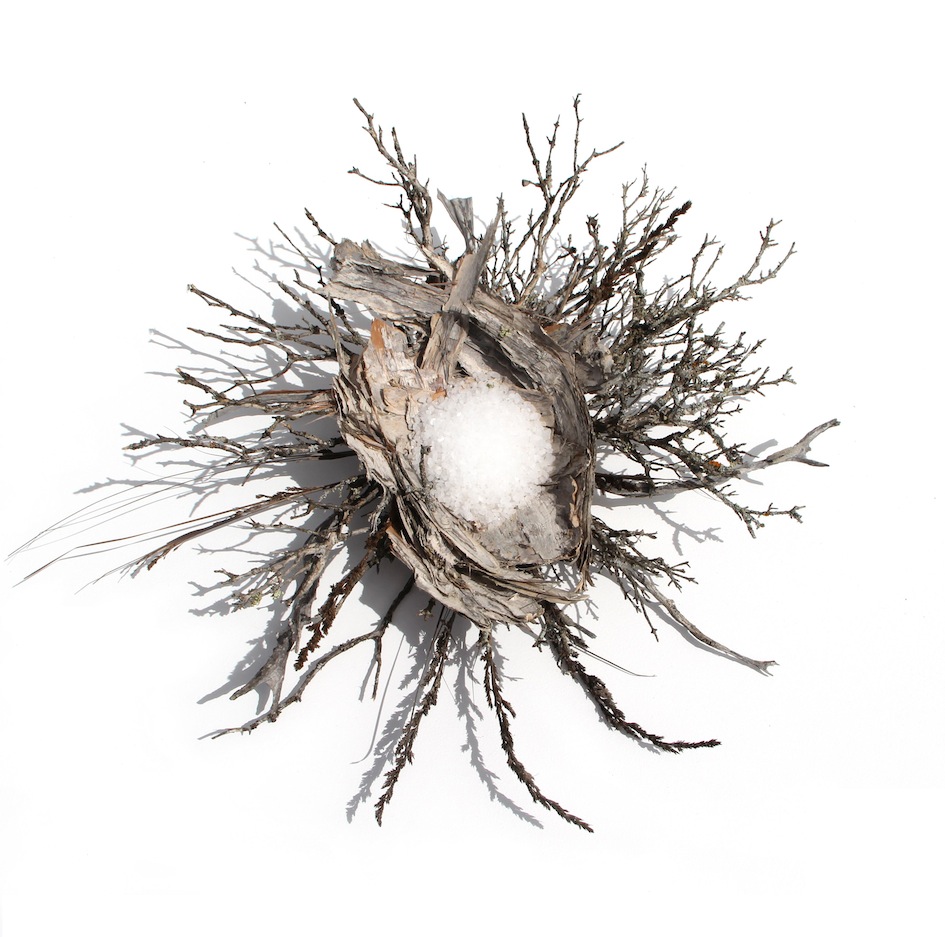Kangaroo Island Native Vegetation Threat Series
Many people see our native vegetation as a grey-green scratchy blur. Yet closer inspection reveals unique wondrous details – a wild precious mix of natural resources that should be treasured. Many people also consider our bush to be indestructible, that no amount of clearing or burning will stop it. This is a myth. Our native ecology is fragile and has suffered from centuries of abuse. Even on Kangaroo Island, which is prized for its pristine habitat, the threats to native vegetation are numerous. This basket series seeks to highlight some of those threats.
 Fire
Fire
Burnt Desert Banksia (Banksia ornata), Radiata Pine (Pinus Radiata) cones
These burnt twigs were collected from a National Park asset protection prescribed burn site – adjacent to a redundant mono-culture tree plantation business. If a business enterprise chooses to position itself beside a priceless public asset, they should provide their own fire breaks, on their own land. Burning parks is risky, costly and introduces weeds and many species, such as banksias, can’t tolerate frequent burns.
SOLD
 Roads
Roads
Shredded car tyre and echidna spines (roadkill)
We are losing our beautiful arbours and precious endemic vegetation as the hydro-axe widens the island’s roads. I pulled over to collect this shredded car tyre and found a roadkill echidna amongst it.
SOLD
 Weeds
Weeds
Tree Lucerne, Bridal Creeper, Radiata Pine, Watsonia, Olive, Boxthorn, Hare’s-tail Grass, Kikuyu Grass and European Honeybee wax
Dozens of weed species smother and out-compete our unique native vegetation and inadequate resources are available for their control (1.5 paid staff island-wide). We should also acknowledge the major contribution honeybees make to the pollination of co-evolved exotic weeds.
 Salt
Salt
Swamp Paperbark (Melaleuca halmaturorum), Cutting Grass (Gahnia trifida) and salt
Excessive vegetation clearance has caused the water table to rise, bringing with it deadly salt. This salt-burnt Swamp Paperbark and Cutting Grass were collected from our “freshwater” lagoon, home to many wetland birds.
SOLD
 Phytophthora
Phytophthora
Kangaroo Island Conesticks (Petrophile multisecta), Drooping Sheoak (Allocasuarina verticillata), Silver Banksia (Banksia marginata), 1 teaspoon soil
It only takes a single teaspoon of contaminated soil to introduce this deadly root fungus into an area. It’s a tragedy that our island wasn’t quarantined from phytophthora as myriad native species are susceptible to it, including the banksias, yaccas, sheoaks and endemic Kangaroo Island Conesticks.
SOLD
 Grain
Grain
Coastal White Mallee (Eucalyptus diversifolia), Kangaroo Island Narrow-leaved Mallee (E.cneorifolia), Cup Gum (E. cosmophylla) (paddock trees), chainsaw chain, bird’s nest and wheat
I mean BIG grain. There’s a corporate push to remove old paddock trees, which are shelter for pasture animals, to make way for large scale cropping machinery. Too soon our island could look like the Murray Mallee and Yorke Peninsula. I see this as a threat to native vegetation, the fauna it supports and also traditional family farms.
SOLD
© Janine Mackintosh, All Rights Reserved 2021
